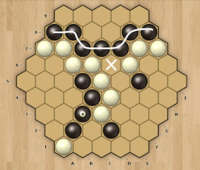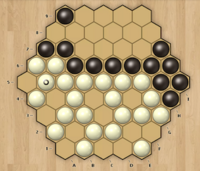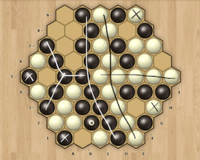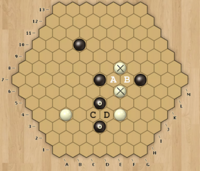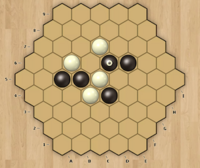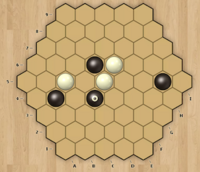This is a documentation for Board Game Arena: play board games online !
Tips lifeline: Difference between revisions
m (Add a note about viewing images on the BGA wiki entry for lifelife in the strategy tips section of a game.) |
m (fixing typos) |
||
| Line 55: | Line 55: | ||
=== Wheel template === | === Wheel template === | ||
[[File:Lifeline_connection_2.png|200px|thumb|right|Image 7: Wheel template in Lifeline.]] Again in the game of Hex | [[File:Lifeline_connection_2.png|200px|thumb|right|Image 7: Wheel template in Lifeline.]] Again in the game of Hex the three White stones marked with X's make what is known as a wheel ''interior template''. You don't have to worry too much about the choice of naming, maybe the three pieces resemble spokes of a bicycle wheels, but in the game of Hex, which is all about connections, one might study connected shapes and ways to link them together in order to win. All we need to know here though, is that the three White stones can't be separated by Black, which make it a quite useful shape to make when changing directions of hex jumps and separating the opponents stones. | ||
=== Cutting tactics on smaller boards === | === Cutting tactics on smaller boards === | ||
| Line 63: | Line 63: | ||
[[File:Lifeline_cutting_1.png|200px|thumb|left|Image 8: Cutting move 1, White cannot connect.]] In images 8 and 9, Black is cutting the White groups, and White cannot connect their stones. This is because White only has two groups on the board in total and joining them together would be a self-capturing move. Therefore Black, in this case, can use it to their advantage. | [[File:Lifeline_cutting_1.png|200px|thumb|left|Image 8: Cutting move 1, White cannot connect.]] In images 8 and 9, Black is cutting the White groups, and White cannot connect their stones. This is because White only has two groups on the board in total and joining them together would be a self-capturing move. Therefore Black, in this case, can use it to their advantage. | ||
In Image 8, Black cuts the Wheel connection from the previous section | In Image 8, Black cuts the Wheel connection from the previous section, while in Image 9 Black jumps across the one space gap between Whites stones utilising the fact they can't connect to cut across them efficiently. If White plays a separate stone elsewhere, Black has time to connect their groups and cut White. | ||
[[File:Lifeline_cutting_2.png|200px|thumb|right|Image 9: Cutting move 2, White cannot connect.]] | [[File:Lifeline_cutting_2.png|200px|thumb|right|Image 9: Cutting move 2, White cannot connect.]] | ||
Revision as of 02:37, 29 December 2022
Note: Images will not display correctly within the "Strategy tips" tab of a game of Lifeline. However if you are viewing this from the BGA game page, you can view the wiki page which includes images by following the links above.
Quick Tips
If you don't want to read the full strategy section, then this quick summary might be helpful to give you some ideas:
- Aim to surround more of the board than your opponent, that is aim to surround the bigger half.
- Taking the bigger half might mean creating a group going through the centre of the board, though this could depend on board size. It seems effective on board sizes 5-8 for example.
- Try to connect your groups and separate the opponents groups, but remember to always have two groups in areas of the board you want to continue to play in. You always need at least two groups on the board in the same area.
- If you can surround an area, with a single separate stone of your colour and none of the opponents stones inside, it is very good. The group won't be capturable until you are forced to self capture.
- If you can divide an area in two, with enough space for two separate single stones, one in each area, it is also good. With good play, the group won't be capturable by your opponent.
- If both players have uncapturable groups, then it will be important to reserve space/territory that only you can play in. This can come from capturing groups, or by surrounding areas where your opponent has no stones inside.
- Win by capturing all the opponents groups, or by outlasting them by making uncapturable groups, and reserving space only you can play in for the end of the game.
Annihilation and Winning
The objective as stated in the game is to win by making the last placement, but an effective way to do this in Lifeline is to capture all your opponents pieces or to outlast your opponents groups so that they self-capture first.
In the first case, this is an annihilation victory. If you've played a few games on BGA, you'll notice the game ends immediately when you remove your opponents last stones from the board. Every future move is illegal for them, since each player needs two separate groups of stones on the board at a minimum to be able to place new stones, so your last capturing move was the last move of the game and you win. In the second case, your opponent might have self-captured their own stones, and you need to place one more stone before winning.
The way to annihilate the opponents groups of stones is to surround and separate them. Surrounding groups will confine them to a particular area on the board, where you can separate them to capture them. Here are some pictures showing examples of ways to capture opponents groups of stones:
In Image 1, Black's last move at C3 allows White to capture the marked black stones with their next move. White can play at the point F6 marked with an X, to both surround the black group and separate it from all other black groups. That is, there will be no paths of empty space from the black marked group to any other black group, and hence it will be captured.
In Image 2, White has surrounded the marked Black groups and will be able to separate them with their next move. White can play at the point C4 marked with an X, to separate both marked black groups groups from each other. That is there will be no paths of empty space between the marked black marked groups, or to any other black group, and hence it will be captured.
Living and Uncapturable Groups
Since there's no passing in Lifeline, one or possibly even both players will eventually lose all of their stones on the board, with some combination of capturing opponents groups and self capturing ones own groups.
However it's still useful to distinguish between groups that your opponent can capture, which one might call dead groups, and ones which the opponent can't capture, which one calls alive or living groups. There's three known types of living groups that are worth distinguishing between when discussing living groups, and the example images below will show these:
Type 1 - living with territory
In Image 3 both White and Black have surrounded separate sides of the board, with no opponents stones inside. This means each player cannot capture the opponent and it also means that they have reserved areas for themselves to play in, which one calls territory. Black has 11 points of territory and White has 9 points of territory. Each player has a singleton group inside their area also, which as long as they don't connect to the larger group, will mean that the groups will remain on the board until they are forced to connect them. At this point of the game, both players would take turns playing on their side of the board, leaving three spaces around the single stone, until the player with less moves left (White in this case) is forced to capture their own group.
Type 2 - living in "double half-seki"
In Image 4, White and Black have both divided their respective areas in two. In each area they have a singleton group marked with an X. While each of the stones marked with an X could be captured, doing so would also self capture the surrounding stones, enabling the group to live like in type 1 above, by replacing the captured stone immediately. So players will choose not to capture these singleton stones. Similarly each player will not connect their singleton stones to the main group, as doing so would enable the opponent to capture the other singleton and the whole group in one move. Players familiar with the concept of "seki" in the game of Go, will note that this is quite similar. There's two areas where neither player wants to capture the other, which is this concept of seki or mutual life. Since this type of life requires two areas to set up, each area is half of the seki, hence the named coined by user ManaT, "double half-seki". In this example Black also has a third area reserved for themselves, which doesn't have another space for a single stone, but functions the same as territory in type 1 example above so might as well also be called territory.
Type 3 - Single area seki
This type of seki or mutual life, in comparison to the type 2 example above, only requires one area with a single stone or group separate from the main one. It is typically a lot harder to set up, and seen a bit less frequently than the other two types in gameplay so far, but possibly further experience and study might lead to more concrete ways to set it up reliably.
In Image 5 the black group is alive and can't be captured because of the single stone at H5 marked with an X. Black will not want to capture the remaining White stones or they will be captured themselves. The reason the black group can't be captured by White is to do with the shape of the area and placement of the white stones within. So far, this type of seki (mutual) life seems to show up mostly with a ring type area surrounding the single stone or group. The key feature of this type of life, is that in order to capture the central group or stone, White needs to completely surround it in order to cut it off, which in turn will connect all of Whites stones together. If White can connect their groups only when the last surrounding move is played then White can safely capture the stones. Here however, White will always join their groups up before surrounding the black single stone. For example, since all spots on the white ring need to be filled to capture, supposing the two spots marked with arrows are the last two to be filled, then either move will connect and self capture Whites stones before fully surrounding the black stone. Just to reemphasise, there will be no single surrounding move that captures, both arrow moves would need to be played at the same time in order for this to happen for instance. So there's no way for White to capture the black groups.
Connecting and cutting groups
It might be useful for players to learn about some of the group connection ideas on the hexagonal game board. Players familiar with the game of Hex will be also be familiar with the following concepts, but we introduce some basic connected shapes to help those unfamiliar.
Hex bridges
Hex bridges are a basic connecting shape in the game of Hex. Rather than placing stones directly adjacent to previous stones, one can jump one space away while staying connected, in a particular shape which is called the Hex bridge. In Image 6, both players are playing Hex bridges to quickly jump across and wall off areas of the board. Whites stones marked with X's are connected with a Hex bridge shape, as if Black tries to separate with A, White can connect with B and vice versa. In Go it might be said that A and B are miai. Essentially it means that there are two options and you're guaranteed one as the White player. Similarly Blacks stones marked with O's and connected with a Hex bridge, as Black can connect with either C or D.
Wheel template
Again in the game of Hex the three White stones marked with X's make what is known as a wheel interior template. You don't have to worry too much about the choice of naming, maybe the three pieces resemble spokes of a bicycle wheels, but in the game of Hex, which is all about connections, one might study connected shapes and ways to link them together in order to win. All we need to know here though, is that the three White stones can't be separated by Black, which make it a quite useful shape to make when changing directions of hex jumps and separating the opponents stones.
Cutting tactics on smaller boards
On smaller sized boards of Lifeline in particular, certain cutting tactics turn out to be quite important, though in principle the same ideas can apply to smaller separated areas on larger sized boards .
In images 8 and 9, Black is cutting the White groups, and White cannot connect their stones. This is because White only has two groups on the board in total and joining them together would be a self-capturing move. Therefore Black, in this case, can use it to their advantage.
In Image 8, Black cuts the Wheel connection from the previous section, while in Image 9 Black jumps across the one space gap between Whites stones utilising the fact they can't connect to cut across them efficiently. If White plays a separate stone elsewhere, Black has time to connect their groups and cut White.
